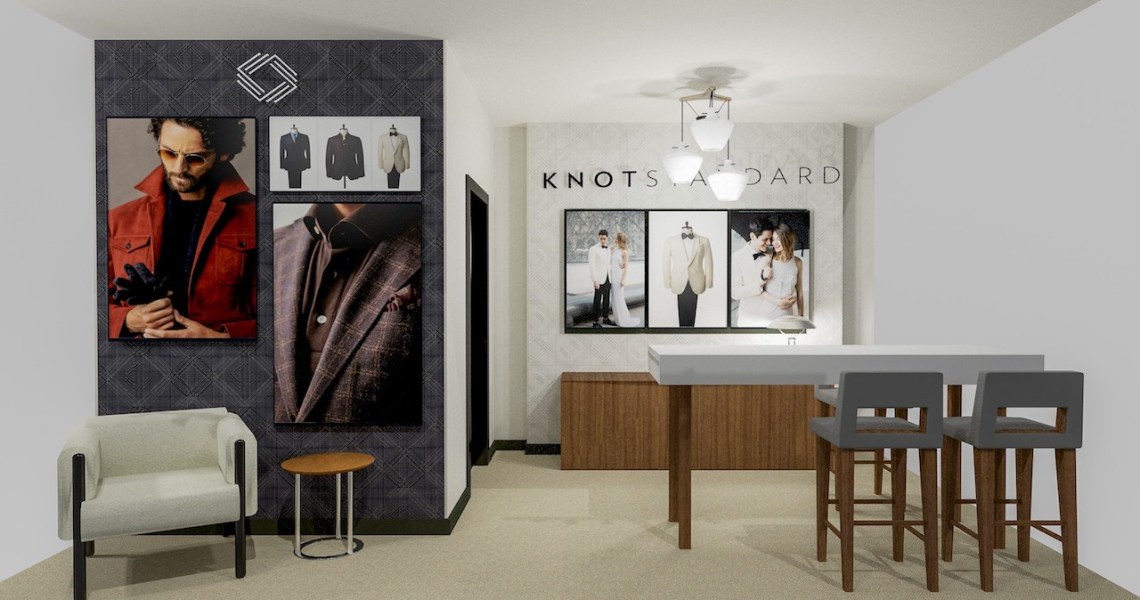Fashion consumers are increasingly expecting brands to offer some form of customization from brands, and brands are responding.
Knot Standard, a made-to-order menswear brand founded in 2012, has been doing customization since day one. But now the brand is taking that idea to the next level, making the online and in-store shopping for its customized products as seamless as possible. This week, the brand will be rolling out data-driven, technology-powered “style walls” in all 10 of its showrooms across the U.S.
The voice-activated style walls, which are 8- to 12-feet long by 8-feet high, feature life-size renderings of styles that change as customers select features. They allow store associates to show shoppers what a custom piece will look like before it’s made. For customers who have never shopped custom before, the tool will help take the guesswork out of the process, said Knot Standard president and co-founder Matt Mueller.
Currently, the style walls recognize over 200 voice commands, with plans to add 50 to 100 new commands each week over the coming months. For example, a customer or stylist can say “shirt cuffs,” and a range of cuffs will appear on the screens. If they say “midnight blue tuxedo jackets,” a range of jacket styles, in various fabrics and shades of midnight blue, will pop up.
“New clients that walk into our showrooms can be a little like deer in the headlights,” said Mueller. “They don’t know how to navigate custom. This shows them the universe much quicker.” Customizing a piece with the new visual tool now takes just minutes.
More than 50% of consumers have said they would purchase customized products, and brands from Nike, Burberry and Jack Rogers have all given customers a chance to do so.
Knot Standard’s screens are customized to customers, based in their preferences and buying history. And, though multiple customers can be in the showroom at a time (the New York showroom can handle up to six shoppers at once), it’s set up to feel like a personal art gallery for each customer, said Mueller.
Ad position: web_incontent_pos1
“You can’t change over an entire North Face store when someone walks in, but we actually can,” said Mueller. There’s no inventory in the store, as all styles are custom-made. Along with giving customers a sense of what the yet-to-be-purchased custom pieces will look like, the screens show customers how styles they’re they’re eyeing can work with other pieces already in their closet and offers up style suggestions for completing an outfit. On the screen, customers are shown product shots, sketches of designs and videos of models wearing the different products.
Data plays a key role in getting these walls to spit out the optimum color, fit and styles for every customer walking through the door. Since launching, Knot Standard has gathered data from over 25,000 previous in-person client appointments.
“We have more data than Amazon, Google or Mr. Porter on the customer’s personal style,” said Mueller. “We look at everything, from what the client told us they like and don’t like, to what they’ve clicked on online or in the emails our stylists and marketing team have sent, to what they’ve told us through individual surveys.”
To promote the new in-store tech-powered tools, Knot Standard is relying mostly on its stylists to spread the word to existing customers. “We really built this for our repeat customers. Sixty percent of our clients will come back and buy more within the first year, and they’re where all of our referrals come from,” Mueller said.
“We’re bullish that the integration of digital imagery will continue to facilitate the process of online re-ordering from our repeat customer base, while providing a more dynamic experience for customers shopping in our showroom,” said Knot Standard CEO and co-founder John Ballay.




